Here are 10 things you should know about Maureen O’Sullivan, born 111 years ago today. This Irish lass sort of stumbled into her movie career, but she made the most of it.
Tag: Frank Borzage
Happy 105th birthday, Maureen O’Sullivan!
Maureen O’Sullivan was born 105 years ago today in County Roscommon, Ireland, of Irish, English and Scottish descent. Here are some fun facts about one of our favorite Irish lasses:
- As a girl, O’Sullivan was a classmate of Vivien Leigh at Roehampton (now Woldingham School), a convent school just outside of London. O’Sullivan’s father sent her there because he felt her Irish brogue was getting too thick.
- Maureen O’Sullivan was discovered by director Frank Borzage while he was in Dublin shooting Song o’ My Heart (1930). He gave her a screen test, offered her a role and she returned with him to Hollywood to complete the filming. Once she was settled in Hollywood, she was offered many other parts.
- In 1932, O’Sullivan starred opposite Johnny Weismuller in Tarzan the Ape Man. The film was such a success that the two were paired in five more Tarzan pictures.
- Maureen O’Sullivan costarred opposite the Marx Brothers in A Day at the Races (1937). Groucho Marx was quite taken with her, but she did not return his interest, to his lasting regret (he was still speaking longingly of her decades later).
- O’Sullivan reined in her very successul career so that she might care for her husband, Australian screenwriter and director John Farrow, when he returned from Naval service in World War II with typhus (or typhoid—we were unable to confirm which it was), but she continued to make occasional appearances in movies, on stage and on television until just a few years before she died in 1998.
- Maureen O’Sullivan and John Farrow had seven children, among them actress Mia Farrow.
- O’Sullivan hated working with Cheetah in the Tarzan pictures, referring to the chimp in private as “that ape son of a bitch.”
- When Maureen O’Sullivan met Clark Gable in 1932, he was wearing old-age makeup and she rebuffed his offer of a date to go horseback riding. When she finally saw him san makeup, she regretted the decision, but he never asked her out again.
- Politically, O’Sullivan was a lifelong liberal and supported many charitable causes, among them UNICEF, The United Nations and Habitat for Humanity.
- Maureen O’Sullivan made her first stage appearance at the suggestion of actor Pat O’Brien in a 1961 Chicago production of “A Roomful of Roses.”
- O’Sullivan became a US citizen on October 22, 1947
- Maureen O’Sullivan died in Scottsdale, Arizona, on June 23, 1998; she was 87. She is buried at Most Holy Redeemer Cemetery, Niskayuna, New York, the hometown of her second husband, James Cushing.
Happy birthday, Ms. O’Sullivan, wherever you may be!
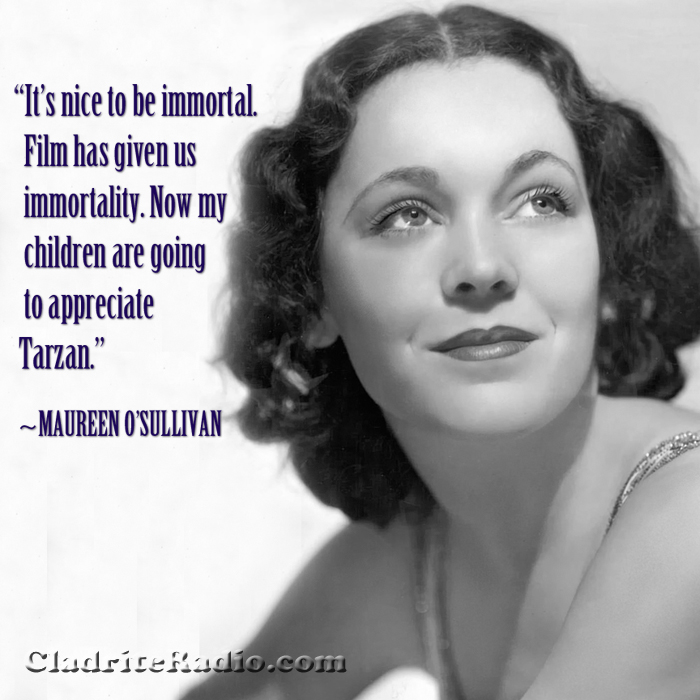
Full Speed Ahead
We’re surely not the first old-movie buffs to notice that there are many more scenes set on cruise ships in pictures from the 1920s, ’30s and ’40s than in contemporary movies. And traveling by boat in those days included no karaoke bars, miniature golf, or rock-climbing walls.
No, activities on an oceanic cruise in those days were limited to drinking cocktails, strolling the decks, reading, playing cards, and if you were lucky, falling in love with an urbane and sophisticated escaped convict or a beautiful woman with a terminal illness.
We love scenes—heck, even entire movies—set on cruise ships, and we’ve often found ourself wondering what the wording was on the thing the captain (or one of his underlings) uses to signal (we think) the crew in the engine room that it’s time to power up (or power down) the ship. (We have no earthly idea what the darned thing’s called—it resembles a white sign that has various words and phrases on it and a lever that one moves from one end to the other, with stops along the way—if you’ve seen an old movie with extensive cruise ship footage in it, you’ve probably gotten a glimpse of one.)
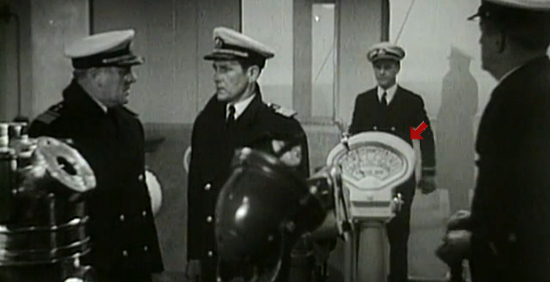
We finally came across a movie—History Is Made at Night (1937), directed by Frank Borzage and starring Jean Arthur, Charles Boyer and Colin Clive—that features not one but two close-up shots of this mysterious device. Finally, we can make out what words and phrases appear on it. And so can you. (FYI: “Princess Irene” is the name of the ship.)
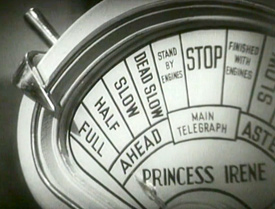 |
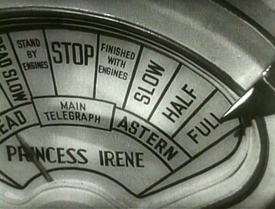 |
We’ll never view another scene set on a cruise ship’s bridge the same way again.
Rattling bones since 1927
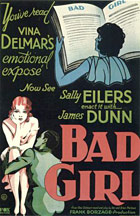 Old movie buffs know that, if you’re watching a picture from the 1920s or early ’30s and it’s set in NYC, there’s a better than even chance there’ll be a scene set at Coney Island.
Old movie buffs know that, if you’re watching a picture from the 1920s or early ’30s and it’s set in NYC, there’s a better than even chance there’ll be a scene set at Coney Island.
And whether those scenes are filmed on a backlot, at a Southern California stand-in amusement park, or, as is sometimes the case, at Coney Island itself, they generally preceded by a scene-setting montage of stock footage shot at Brooklyn’s “Sodom by the Seashore.” You can generally count on seeing some shots of Luna Park and often Steeplechase Park, too, as well as some funhouse footage, with those spinning tubes customers are asked to walk through, the rotating platters they try to avoid being spun off of, and those large slides that were navigated while sitting on a potato sack.
(By the way, it pleases us greatly to recall the funhouses of our own youth and realize that they boasted the same basic features the funhouses of the 1920s did. I suppose there are still funhouses like that around today, but we don’t know where they are. Readers?)
What one doesn’t often see in these montages, though, is footage of those aspects of Coney Island that are still extant today. After all, the original Luna Park is long gone; Steeplechase Park, too. But the iconic rides that still exist—the Wonder Wheel, the Parachute Jump (which is no longer functioning but still stands watch over the surrounding festivities, a landmarked monument)—are rarely seen in these montages.
But while watching Bad Girl, a 1931 NYC-set drama directed by Frank Borzage and starring Sally Eilers, James Dunn and Minna Gombell, the other night, we were tickled to see not only the familiar shots of Luna Park and funhouse footage, but a lingering shot of the Cyclone, an old-school roller coaster that debuted in 1927 and is still rattling bones today. The Cyclone, a beloved Coney Island institution, was designated a New York City landmark in 1988, and was placed on the National Register of Historic Places in 1991. But we don’t think we’ve ever seen it depicted in an old movie. Other Coney coasters, yes, but never the Cyclone.
Here’s the montage we’re speaking of:
If you’ve never taken a spin on the Cyclone, it’s time you did. You’ll exit the ride a bit wobbly-legged and perhaps just a little queazy, but you’ll know you’ve experienced the real deal in the world of roller coasters.
And the winner is…
 There’s no telling what tonight’s broadcast of the Academy Awards will bring — these days, we’re as inclined to jeer the Oscars as cheer them — but we do maintain a fondness for this particular award, above all others, because of the tradition it represents and maintains. After all, this is the same award first presented all the way back in 1929 to Janet Gaynor, Emil Jannings, and Frank Borzage, to wonderful pictures such as Sunrise, The Jazz Singer, 7th Heaven, and Underworld.
There’s no telling what tonight’s broadcast of the Academy Awards will bring — these days, we’re as inclined to jeer the Oscars as cheer them — but we do maintain a fondness for this particular award, above all others, because of the tradition it represents and maintains. After all, this is the same award first presented all the way back in 1929 to Janet Gaynor, Emil Jannings, and Frank Borzage, to wonderful pictures such as Sunrise, The Jazz Singer, 7th Heaven, and Underworld.
And tonight will provide a living link to early Hollywood history, as Lauren Bacall will be the recipient of a lifetime achievement Oscar. Bacall, of course, was married to one of the giants of the golden age of Hollywood, Humphrey Bogart, who made his screen debut in a 1928 Paramount short subject called
